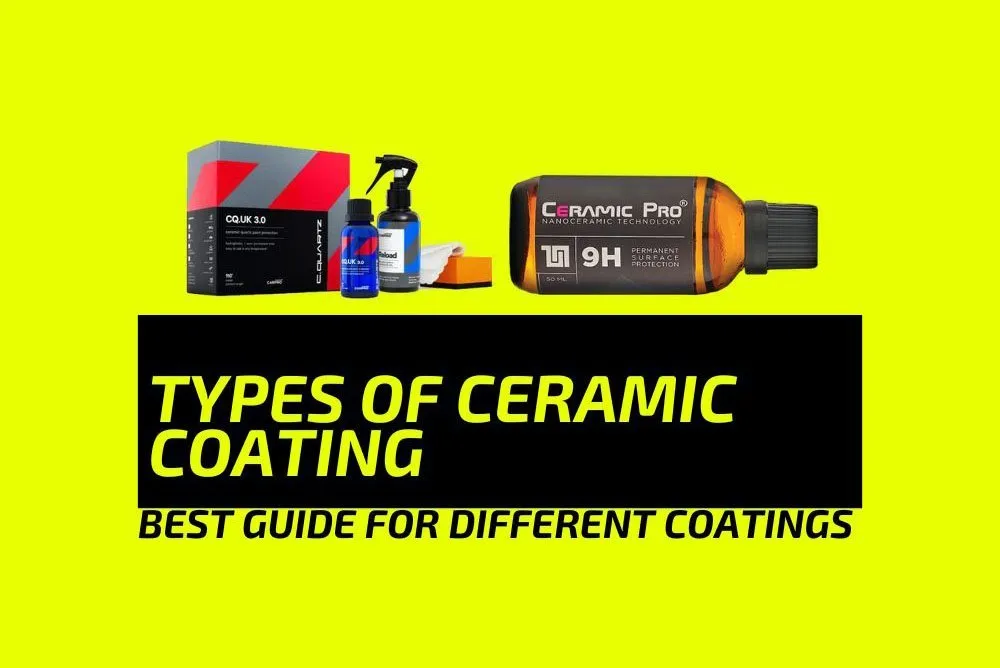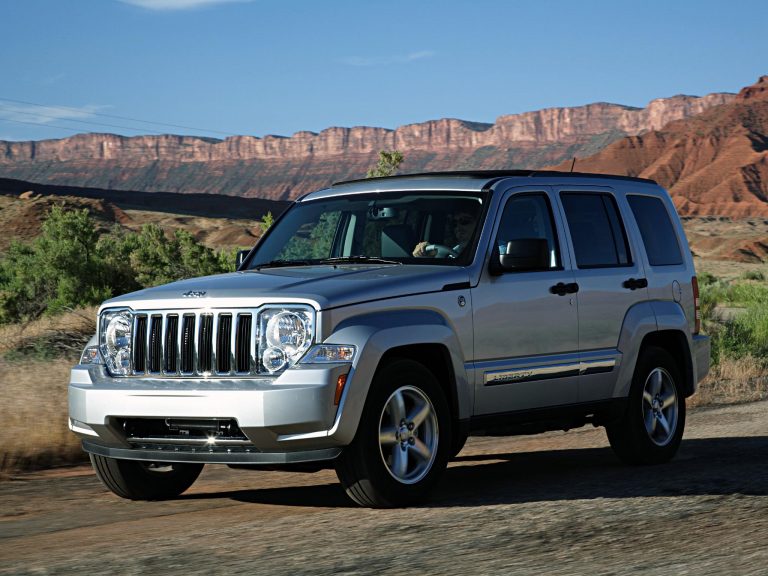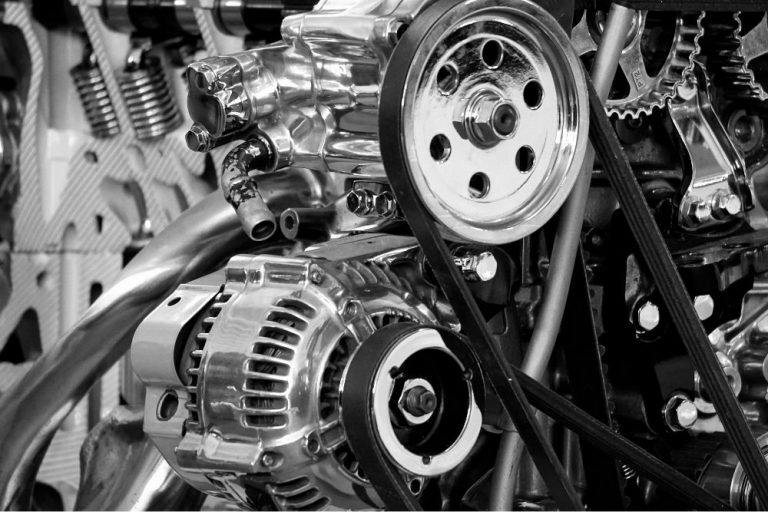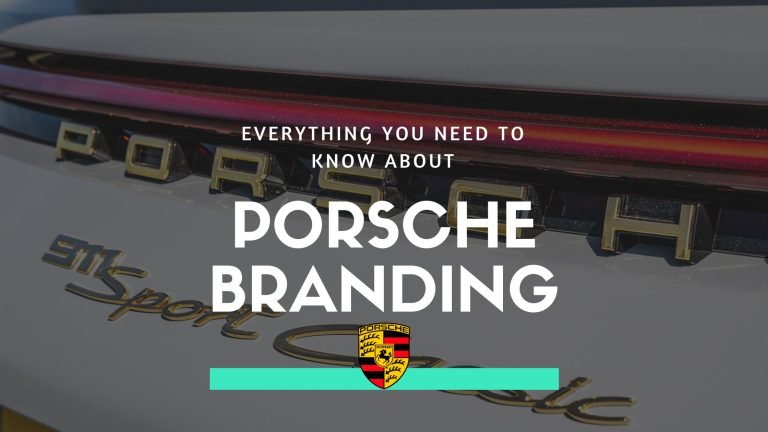Types of Ceramic Coating: Best Guide For Different Coatings
Ceramic coatings have become a popular protection and enhancement method for your vehicle’s paint. They come in a variety of types, each offering unique benefits for your car’s appearance and longevity. Having a good idea of the different options will allow you to choose the best ceramic car coating to suit your needs and preferences.
The whole purpose of ceramic coating a car is to create a barrier between your vehicle’s paint and the elements, keeping it looking fresh and making it easier to maintain. As you explore the world of ceramic coatings, you’ll come across different types like SiO2 (silicon dioxide), TiO2 (titanium dioxide), and hybrid coatings that combine multiple elements. Each type provides specific levels of protection, hardness, and shine, so consider your priorities when deciding which one to use.
Keep in mind that some ceramic coatings require professional application to ensure proper bonding and effectiveness, while others can be applied in a do-it-yourself ceramic coating kit. As you research the various types of ceramic coatings, keep your vehicle’s paint in mind, as well as how much time and effort you’re willing to invest in the application process. Your choice will ultimately impact the longevity and appearance of your car, so make sure you select the most suitable coating for your needs.
TLDR Summary
Ceramic coatings are a popular choice for protecting car surfaces, and there are various types of ceramic coating. One noticeable type is thermal spray coating, which offers high heat resistance and insulation. Plasma spray coating, another type, also provides impressive resistance to wear, corrosion, and friction.
Silicon-based ceramic coatings are widely applied due to their strong adhesion to most substrates and impressive chemical, thermal, and UV resistance. When heat-treated, they transform into ceramic materials known as polymer-derived ceramics, offering even more durability.
Wet chemical and electrochemical coatings represent other variants of ceramic coatings, and they’re used to create high-performance oxide layers on metals and alloys. These layers help tackle corrosion, wear, and insulation issues, enhancing the lifespan of car parts.
When you’re trying to decide which ceramic coating to apply on your car, consider factors such as the car’s surface material, the environment, and the desired level of protection. By selecting the most suitable ceramic coating type, you’ll ensure your car looks great and performs well, even under harsh conditions. So, make an informed decision and enjoy your protected car.
Benefits of Ceramic Coating
Ceramic coating offers a multitude of benefits for your vehicle’s paintwork. For starters, it provides long-lasting protection from various environmental threats such as UV rays and acid rain. This means no more worrying about these harmful elements degrading your car’s finish over time.
With the added protection of a ceramic coating, you can expect reduced instances of swirl marks, which are notoriously frustrating for car owners. Not only do swirl marks reduce the shine and aesthetic of your car, but they can be costly to remove. The protective layer of ceramic coating helps minimize their occurrence, keeping your car paint looking fresh and pristine.
Another advantage of ceramic coatings is their ability to resist bird droppings. When left on the car’s surface, bird droppings can etch into the clear coat, leaving unsightly marks. The protective layer provided by ceramic coating helps prevent damage from droppings, making clean-up easier and saving your paint from permanent harm.
Now, you might be wondering how ceramic coating compares to other forms of paint protection, like paint protection film. While both have their merits, the ceramic coating offers a longer-lasting solution. If you regularly maintain your cars paintwork, a ceramic coating can last for years, providing continual safeguarding for your car’s paintwork.
Here are some key benefits of ceramic coating:
- Provides long-lasting protection
- Defends against UV rays and acid rain
- Reduces swirl marks
- Resists bird droppings
- Outlasts paint protection film
In essence, applying a ceramic coating to your vehicle gives you peace of mind. By investing in this clear, protective layer, you’re ensuring your car’s paintwork remains in top shape for a long time. So go ahead and treat your beloved ride with the care it deserves.
Major Types of Ceramic Coatings
Silicon Dioxide
Silicon dioxide coatings offer a protective layer for your car. When applied, the liquid polymer bonds with your car’s paint, forming a sacrificial layer that helps prevent damage from environmental contaminants like bird droppings, acid rain, or UV rays. This type of coating is very popular, as it extends the life of your paint and makes cleaning your car easier.
Titanium Dioxide
Another popular type of ceramic coating is titanium dioxide, which provides similar protection to silicon dioxide coatings. The main difference between titanium and silicon dioxide is that titanium dioxide coatings can provide enhanced UV resistance, helping to further protect the chance of your car’s paint from fading after being exposed to the sun. Both silicon dioxide and titanium dioxide coatings can make your car look better and last longer.
Quartz Coatings
Quartz coatings consist of nano-ceramic particles that deliver additional durability and hardness to your car’s surface, helping to prevent scratches, scuffs, or other imperfections that might detract from its appearance. These coatings work well for car enthusiasts who want an extra layer of protection that’s both effective and visually appealing.
Graphene Coatings
If you’re looking for another option to help safeguard your car, graphene coatings offer improved hydrophobic properties, which means they can repel water better than other types of ceramic coatings. This feature helps keep your car cleaner for longer periods, reducing the need for frequent washing and maintenance. Additionally, graphene coatings can help dissipate heat from your car’s surface, which may be particularly appealing for drivers in scorching climates.
There you have it—a brief look at various types of ceramic coatings that can help protect and enhance your car’s appearance. Whether you choose silicon dioxide, titanium dioxide, quartz, or graphene coatings, each option offers unique benefits tailored to fit your needs as a car owner. With the right coating, you’ll be able to enjoy your car while keeping it looking fresh and clean.
Application Methods
Professional Ceramic Coating
When it comes to professional ceramic coating, professional detailers have the experience and expertise to get you the best results. They use advanced methods such as detonation guns, oxygen-acetylene powder deposition, chemical vapor deposition, and plasma spraying to apply the ceramic coating. Selecting the right method according to the surface and material ensures long-lasting protection for your car.
DIY Ceramic Coating Kits
If you don’t mind getting into applying it yourself, DIY ceramic coating kits allow you to apply the coat yourself. Gaining experience in proper application techniques is essential for achieving desirable outcomes. Though not as advanced as professional methods, DIY kits can still provide suitable protection if you follow the instructions carefully. Remember to clean the surface thoroughly and remove any dirt or grease before applying the coating.
Ceramic Wax
Ceramic wax is a handy alternative if you’re seeking an easy-to-apply solution for your car. Combining the best of both worlds, it offers the convenience of traditional waxes along with the durability of ceramic coatings. Applying ceramic wax takes less time and effort, as you simply spread it onto the surface and buff it off. However, ceramic wax doesn’t last as long as ceramic coatings, so you’ll need to reapply it more frequently to maintain its protective qualities.
Ceramic Spray Coating
Looking for yet another option? Consider ceramic spray coatings, which are simple and quick to apply. You just spray the coating onto the surface and wipe it off using a microfiber cloth, making it easy to achieve even coverage. Though not as durable as professional ceramic coating or DIY kits, ceramic spray coatings still offer some level of protection for your car. It’s an ideal choice for those who want a cost-effective and user-friendly solution.
By understanding the various application methods and the advantage of each, you’ll be able to make a proper decision about what works best for your car. From professional services to DIY solutions, there’s a ceramic coating option that suits your needs and preferences.
Preparation and Maintenance
Before you go ahead and apply the ceramic coating to your car, proper preparation is essential. Start with paint correction, which involves removing any defects, such as swirls, scratches, or oxidation, on your vehicle. This step will ensure the surface is as smooth as possible, allowing the ceramic coating to bond better and last longer.
To start with paint correction, use a clay bar to remove any contaminants from your car’s paint. The clay bar will pick up dirt, debris, and other particles that can affect the ceramic coating’s performance. After using the clay bar, your car’s surface should be free from any imperfections.
When choosing a ceramic coating product, you should consider factors like durability, hydrophobic properties, and ease of application. Some coatings are easier to apply and maintain, while others offer more protection and last longer. Just consider these things carefully and pick something that suits you the best.
Proper maintenance is key to the longevity of your ceramic coating. Follow these tips to keep your protected car in top shape:
- Perform a maintenance wash by hand every 2-4 weeks to maintain the coating’s effectiveness.
- Use car wash products specifically designed for ceramic coatings to avoid stripping away its protective layer.
- Avoid automated car washes, as they can damage the coating by using harsh cleaning chemicals and brushes.
By following these preparation and maintenance steps, you’ll ensure the ceramic coating on your vehicle protects and preserves your paint. This will keep your car looking new for longer.
Comparing Ceramic Coating Products
When searching for the best ceramic coating for your car, you might come across various brands and products. Among the well-known ones are Ceramic Pro, CarPro CQuartz, and glass coatings. Each product has its unique composition and offers different benefits to keep your car protected, shiny, and easy to maintain.
CarPro CQuartz
CarPro CQuartz, considered by some as the top overall ceramic coating for cars, is a Malta-based company that pioneered automotive ceramic coatings in the early 21st century. Their product, CarPro CQuartz UK 3.0, features a high-quality nanotechnology formula for enhanced performance. This particular coating provides excellent durability, protection against watermarks and stains, and a long-lasting shine.
Ceramic Pro
Ceramic Pro is another reputable ceramic coating brand. They offer a nano-ceramic coating that forms a strong bond with your car’s paint. These nano coatings contain liquid polymers that transform into a protective layer upon application. Ceramic Pro is well-regarded for its protection against UV damage, high gloss finish, and hydrophobic properties, which prevent water from clinging to your car.
Glass Coatings
A glass coating is a type of ceramic coating that primarily focuses on adding a layer of protection to your car’s windshield or visor. They’re formulated to provide increased visibility by repelling rain and dirt while reducing glare. Glass coatings are beneficial for drivers who often commute during rainy weather or opt for long road trips in various conditions.
Teflon-Based Sprays
Teflon-based sprays may not offer the same long-lasting protection as a nano-ceramic coating, but these products still provide a quick, easy, and affordable solution for temporary protection. Teflon coatings help repel dirt and grime, making clean-up a breeze. Although not the most durable option, Teflon-based sprays can be an attractive choice for people who prefer minimal maintenance.
Ultimately, choosing the right ceramic coating product for your car depends on your personal preferences, driving habits, and budget. Each option presents its unique set of benefits and features, so take the time to evaluate which product best suits your needs and keep your car looking fresh and protected.
Factors to Consider
Before choosing a ceramic coating for your car, there are a few factors that you need to consider to make sure you’re getting the best protection for your car. Let’s dive into these considerations.
Firstly, think about the type of coating you want to apply. There are various types of ceramic coatings, some with higher percentages of silicon than others. For instance, Nexgen ceramic sprays contain 13% silicon, which makes them popular among DIY detailers. Higher silicon content will provide your car with better protection.
Next, evaluate the hardness (H) rating of the coating. A higher H rating means increased surface hardness, which provides enhanced protection against scratches and damage from road grime. Opt for a ceramic coating with a high H rating for superior paint protection.
When choosing a ceramic coating, consider its hydrophobic properties. Coatings with strong hydrophobic characteristics help repel water from your car’s surface. This not only makes for easier cleaning but also minimizes the risk of water spots forming on your paintwork.
It is very important to weigh the benefits and drawbacks of ceramic coatings against other protection methods, such as paint protection film and car wax. While ceramic coatings offer long-lasting protection and a glossy finish, paint protection film is thicker and more robust, providing better stone chip protection. Car wax, on the other hand, is less durable but is easy to apply and offers temporary protection against minor scratches and dirt.
Finally, consider whether you want to apply the ceramic coating yourself or seek professional help. Ceramic coating services come with the added benefit of expert advice and workmanship but can be more expensive than a DIY approach. So, if you decide to do it yourself, make sure you complete the entire procedure carefully and allocate ample time for proper preparation and application, as this will ensure a seamless layer of protection for your car.
By taking these factors into consideration, you can make an informed decision on the most suitable ceramic coating for your car, ultimately keeping it looking fresh and in top condition for years to come.
Cost and Longevity
When it comes to the ceramic coating cost for your car, the cost can vary depending on the quality and type of coating you choose. Some great options on the market today include professional-grade coatings, which offer superior protection and a semi-permanent bond with your car’s paint. These coatings typically cost more, but they provide the best choice for ensuring your car stays looking sharp and protected from rock chips, minor scratches, and road debris.
Ceramic coating costs can range from under $100 to several hundred dollars depending on factors like the product’s quality, the professional installation, and the size of your car. You might be tempted to choose a cheaper option, but it’s essential to consider the potential long-term benefits of investing in a better quality coating. A higher-quality ceramic coating will usually last longer and offer more substantial protection, saving you money and time on repairs and touch-ups in the long run.
The longevity of ceramic coatings also depends on the weather conditions your car is exposed to regularly. While no coating is entirely immune to wear and tear from the elements, higher-quality options will better withstand harsh weather conditions and maintain their protective properties over time.
If you’re serious about preserving your car’s appearance and value, it’s worth considering a professional-grade ceramic coating. These coatings create a strong chemical bond with your car’s paint, providing a durable shield against potential damage. While the initial cost may be higher, the investment pays off in the long run through the extended lifetime and enhanced protection your car enjoys.
So, when choosing a ceramic coating for your car, weigh the cost and longevity factors carefully. It is very important to decide on the best option that suits your needs and budget while still providing the level of protection your prized possession deserves.
Wrap Up!
So, you’ve been learning about different types of ceramic coatings for your car, huh? Great! Let’s summarize what we’ve discussed and emphasize some key points to remember.
First, remember that there are DIY ceramic coating kits available for you to give your car a protective barrier. These coatings offer better protection than spray coatings and waxes but require a fair amount of preparation before application. Ranging from $50 to $150, these kits offer an economical option to get quality ceramic protection.
Next, we talked about Nexgen Ceramic Spray Silicon Dioxide, which is great for various vehicle types, such as cars, ATVs, boats, and RVs. This product speeds up the process of applying ceramic coating, making it a convenient choice for those looking for a quicker alternative to traditional coatings.
Additionally, we touched on the topic of wrapping ceramic-coated vehicles. Specifically, it is very important to know that applying a wrap over a ceramic coating is fine, but applying a wrap on a painted surface that has been previously coated with ceramic is not ideal. The coating will create a low surface energy layer that repels water and chemicals, making it hard for the wrap to stick properly.
To make things easier and more fun for you, here’s a quick recap in bullet points:
- DIY ceramic coating kits provide an economical option
- Nexgen Ceramic Spray Silicon Dioxide speeds up the application process
- Wrapping over ceramic-coated surfaces is acceptable, but avoid wrapping on surfaces with prior ceramic coating
With this information, you’re well-equipped to make informed decisions about ceramic coatings for your car. Best of luck, and enjoy the drive!




